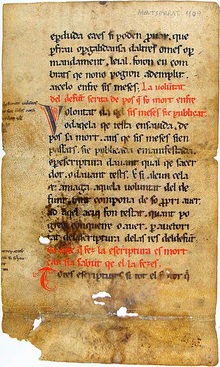Visigothic Code
In this way, all subjects of the kingdom were gathered under the same jurisdiction, eliminating social and legal differences, and allowing greater assimilation of the populations.In 589, at the Third Council of Toledo, the ruling Visigoths and Suebi, who had long practiced Arianism, converted to Latin Catholicism.Particularly with the Visigoth's Law Codes, women could inherit land and title, were allowed to manage land independently from their husbands or male relations, dispose of their property in legal wills if they had no heirs, could represent themselves and bear witness in court by age 14 and arrange for their own marriages by age 20.The code is known to have been preserved by the Moors,[citation needed] as Christians were permitted the use of their own laws, where they did not conflict with those of the conquerors, upon the regular payment of jizya tribute.When Ferdinand III of Castile took Córdoba in the thirteenth century, he ordered that the code be adopted and observed by his subjects, and had it translated, albeit inaccurately, into the Spanish language, as the Fuero Juzgo.

SpanishFuero JuzgoChindasuinthVisigothic KingdomRecceswinthRoman lawGermanic lawcustomary lawCode of EuricAlaric IIBreviary of AlaricLeovigildCodex RevisusThird Council of ToledoArianismLatin CatholicismReccaredold OccitanSanta Maria of Montserrat AbbeyMontserratCataloniaWittizaBraulio of ZaragozaTwelfth Council of ToledoGaliciaCatholic ChurchCanon lawtheocraticFerdinand III of CastileCórdobaSpanish languageOccitan languageoldest literary textsSamuel Parsons ScottApostasyPederastyBetrothedFoundlingsSepulchresEarly Germanic lawSalic lawCode (law)Edward James